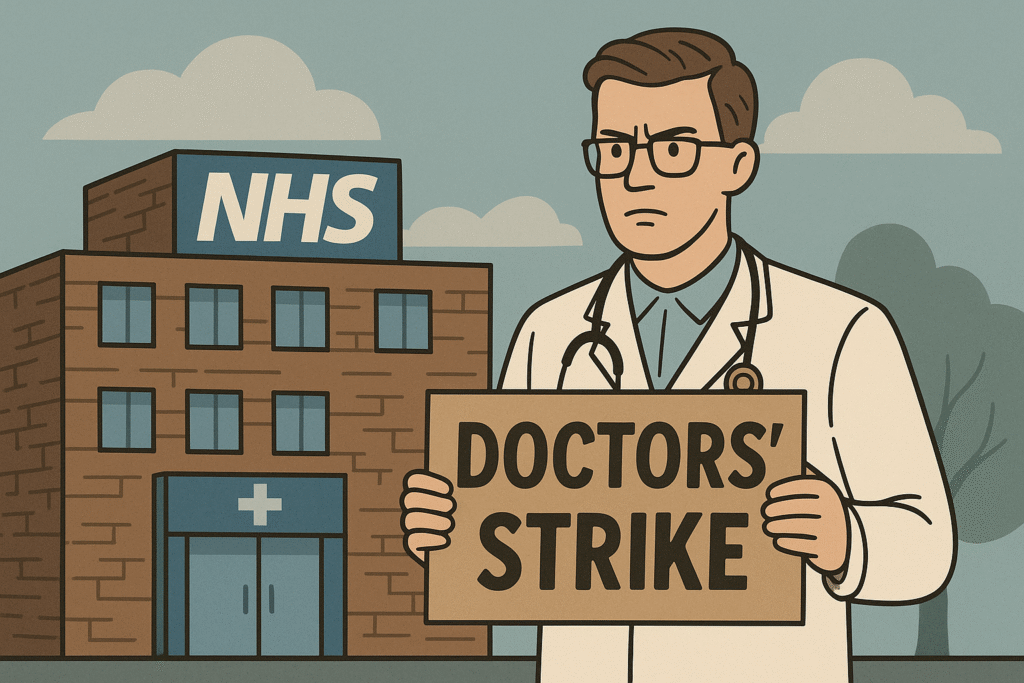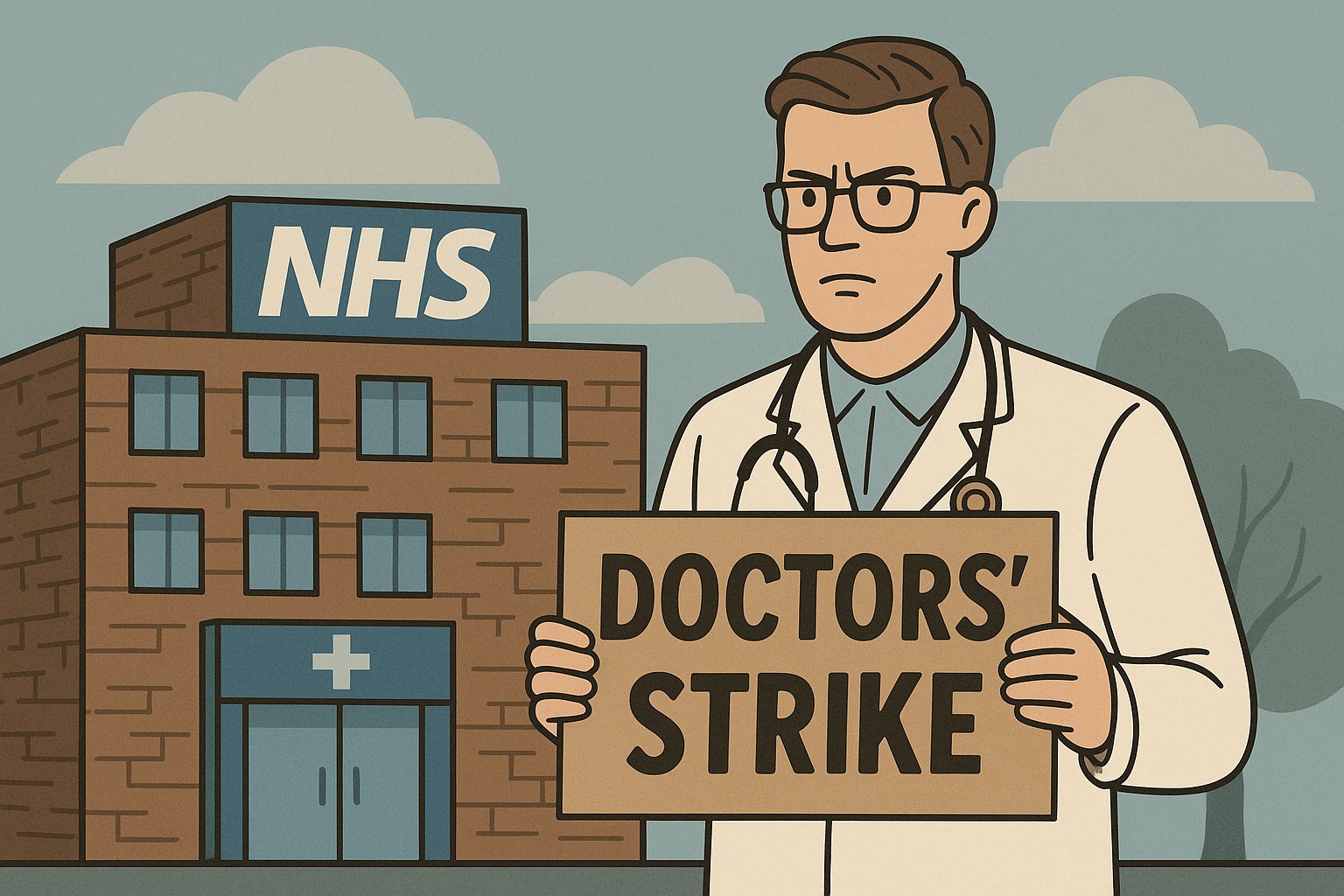The UK’s cherished National Health Service (NHS) has shown signs of recovery in recent months, but that progress is now under significant threat. A new hurdle to NHS gains has emerged in the form of a looming junior doctors’ strike, organized by the British Medical Association (BMA), which has the potential to undo critical progress made in patient care and waiting list reductions.
While recent indicators had finally begun to trend positively—shorter waiting lists, increased patient satisfaction, and more efficient GP systems—the proposed five-day walkout from July 25 to 30 has thrown a wrench into the works. This new hurdle to NHS gains risks derailing not only the public’s fragile optimism but also the broader structural reforms just beginning to take hold under the new health secretary, Wes Streeting.
Positive Developments Before the Disruption
Before this new hurdle to NHS gains surfaced, the NHS had some genuine wins to celebrate. Data released in May showed that waiting lists were falling at the fastest rate in two years, a milestone that health officials and patients alike welcomed. A total of 7.36 million patients remain on waiting lists, but the trend has shifted downward for the first time in recent memory.
Even more impressive was the record number of treatments performed, demonstrating increased capacity and improved management. Combined with rising satisfaction in GP services—where 70% of patients reported being satisfied with how they contacted their GP and 75% praised their overall experience—there was cautious hope that the NHS was turning a corner.
Technological innovations such as NHS app-based bookings and expanded phone consultations have significantly reduced the dreaded 8am rush. These developments were starting to remove traditional bottlenecks, hinting at smoother operations ahead. However, this progress now faces a new hurdle to NHS gains with the BMA’s call for industrial action.
The Strike Vote and Its Consequences
The BMA’s announcement came swiftly, following a 90% vote by junior doctors in favor of strike action, with only two weeks’ notice. Though the level of support seems overwhelming, the actual turnout fell to 55%, down from 71% in the previous vote—suggesting growing dissent or disillusionment within the ranks.
This rushed decision represents a new hurdle to NHS gains, placing managers in a difficult position with little time to reschedule appointments or reassign critical duties. The strike, scheduled for five days, will mark the 12th walkout since 2022. Previous strikes have already resulted in the loss of 1.3 million healthcare appointments and an estimated financial toll of £1.5 billion.
For a system slowly trying to recover, these repeated disruptions form a relentless new hurdle to NHS gains, pulling resources away from patient care and undermining staff morale.
Financial Demands and Public Sympathy
The BMA has made bold financial demands, seeking a 29% pay restoration to pre-2008 levels. While the union claims that junior doctors’ real wages have fallen significantly, there’s disagreement over how this is measured. The BMA uses the Retail Prices Index (RPI), suggesting a 29% shortfall, while the Office for National Statistics (ONS) uses the Consumer Price Index (CPI), putting the figure at a 4.7% drop.
Regardless of methodology, the scale of the demand appears disconnected from current fiscal realities. The NHS already accounts for 40% of departmental public spending, and Streeting’s most recent settlement with junior doctors offered a 22.3% increase over two years, with a further 5.4% above-inflation raise this year—totalling a 28.9% boost over three years. Starting salaries are up by £9,500.
Yet, for many within the BMA, that’s still not enough. Their language—labeling offers “derisory” and “insulting”—has begun to alienate segments of the public. In fact, a recent YouGov poll showed 48% of the public now oppose further strike action, compared to 39% who support it.
This shift in sentiment represents a serious new hurdle to NHS gains, as diminished public backing can weaken the collective momentum needed to bring meaningful reforms.
Unequal Gains Across NHS Staff
The disparity in pay settlements across NHS departments has also become a new hurdle to NHS gains. Nurses, physiotherapists, and midwives were offered a modest 3.6% rise compared to junior doctors’ 28.9%. This imbalance risks creating tension among healthcare staff and could lead to fractured solidarity.
Other unions have voiced only lukewarm support for the BMA’s aggressive tactics, further complicating the labor landscape. Consultants, who are also balloting for strikes, may intensify the pressure on a system already stretched to its limits.
Structural Career Challenges Overshadow Pay
For many junior doctors, the new hurdle to NHS gains is not just about pay—it’s about their future. The bottleneck in medical career progression has worsened dramatically. Five applicants now compete for every specialty training post, up from 2:1 just five years ago.
This stop-start planning by successive governments has left 20,000 doctors without clear career paths, fueling frustration and burnout. Streeting has pledged to prioritize UK-trained doctors for these roles and added 2,000 GP posts by reforming hiring structures. But these moves will take time, and trust must be rebuilt between leadership and the workforce.
A Climate of Financial Strain and Political Pressure
This new hurdle to NHS gains arrives during a broader economic slowdown, exacerbated by Brexit-related trade issues and global crises. Public and private sector wages have both struggled to keep pace with inflation, and the government has limited fiscal room for major spending increases.
Using general NHS funds to meet a 29% wage increase appears fiscally unsustainable, especially when the previous raise required eliminating NHS England. With the service already on thin ice, asking for more funds risks alienating both government support and public empathy.
Political Landscape and Cultural Memory
Historically, conflicts between doctors and politicians rarely end well for health secretaries. But this time, public sentiment appears less forgiving toward the union. Cultural portrayals, like the National Theatre’s play Nye, have rekindled support for the NHS as an institution but also revealed growing skepticism about union strategies.
The play’s depiction of Bevan challenging the British Medical Association for obstructing NHS founding ideals resonated with audiences—many of whom seemed more aligned with patients than doctors. This reflects another new hurdle to NHS gains: how the BMA’s public image is evolving in a time when unity is essential.
A Long-Term Vision at Risk
Wes Streeting’s 10-year NHS plan—emphasizing prevention, local clinics, and digital innovation—has been well-received in principle. However, repeated strike actions, like this new hurdle to NHS gains, risk delaying or derailing these reforms.
With so many past “long-term plans” having failed, there’s growing skepticism that even this one can survive long enough to deliver. Nonetheless, its grassroots focus and support from polling suggest a roadmap worth preserving.
Conclusion: Recovery at a Crossroads
The NHS is at a critical inflection point. While positive strides have been made in reducing waiting lists and improving GP access, the upcoming strike represents a serious new hurdle to NHS gains.
If the BMA and government cannot find common ground, patient care will suffer, public support will wane, and structural reform will stall. At stake is not just the future of NHS staff salaries, but the sustainability of the entire public healthcare system.
For now, the message is clear: the NHS needs unity, not division. And this new hurdle to NHS gains must be overcome with reason, compromise, and shared purpose.

